Art × Science: Face Project
<Production Report No. 2> Audrey Hepburn Sculpted in Clay Careful Planning to Bring Alluring Expressions to Life
This is an English translation of information in Japanese on November 27, 2020.
In May of 2019, Kao began working with the contemporary sculptor Kazu Hiro in a joint research project to sculpt and cast two ultra-realistic portraits of Audrey Hepburn at double her real-life size. Through the process, Kazu Hiro and Kao used artistic and scientific methods to explore the elements that make a human face radiant and unique.
This series focuses on the process Kazu Hiro used to create lifelike portraits. This second report describes how Kazu completed two clay sculptures of Audrey Hepburn, one when she was young, the other during her final years.
Clay sculptures of meticulous accuracy
A special-effects makeup artist's work to create a face generally begins with the creation of a lifecast, a replica of a model's face produced with a plaster mold. The duplication of Audrey Hepburn's face had to be handled by other means, as no lifecast or other three-dimensional records of her face are known to remain. To faithfully reproduce the size and shape of Hepburn's face and the gradations of her expressions, Kazu had to rely solely on two-dimensional materials such as photographs and video footage.
To determine the exact proportions of Hepburn's face, Kazu gathered photographs of her face viewed from the front and from the sides. Ideally, he hoped to work with photographs taken at around the same time, preferably on the same day. In a stroke of good luck, Kazu found a set of photographs taken on the same day showing Hepburn directly from the front and in profile. With them he commenced an intricate set of steps to accurately recreate the face in three dimensions.
Two important reference values for this recreation were the diameter of Hepburn's irises and the height of her body. A person's iris is generally uniform in shape and size, with a diameter ranging from 11.5 to 13.5 millimeters. Kazu deduced the size of Hepburn's irises and the distance between her eyes from the photographs. He then estimated the size of her face and the distances between its respective parts by comparing his measurements with a lifecast of a woman of approximately the same height. His next step was to actually create the face in clay.
Asymmetry of the face
Kazu Hiro chose a young Audrey Hepburn, still in her earlier twenties, for the first of his two sculptures. Then, while formulating her proportions for the work, he noticed something remarkable.
The attractiveness of a face is often said to lie in the horizontal symmetry of its features. Hepburn's face was close to symmetrical, but careful observation revealed several subtle idiosyncrasies: her left eye was slightly larger than the right, the outer corner of her left eye was slightly raised, and the cartilage of the left side of her nose was slightly lower. To render Hepburn's face with a smile, as he wished, Kazu had to solve the difficult task of duplicating an asymmetry he observed in Hepburn's eyes and in the angles of her eyebrows. He also noticed that Hepburn looked more attractive when seen from the left. She was likely to have known the same thing herself, as many more of her photographs were taken from the left. In looking through photographs of her facing the right, he discovered that many were inversions of photographs actually taken from the left.
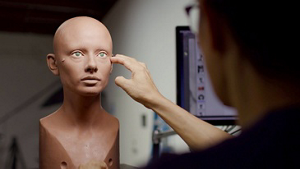
By tilting her head slightly to the left and directing her gaze leftward in this sculpture, Kazu hoped that people viewing the face would follow the direction of her gaze and focus more closely on the left side of her face.
Once he completed the proportions of Hepburn's face when young, Kazu sculpted the face wearing a neutral expression and then made a 3D scan. The smiling expression of the final sculpture was only arranged after the data of the neutral face was obtained as reference data for the second sculpture of Hepburn later in life.
He then used the data to print a plastic image of the face with a 3D printer, produced a mold from it, and applied clay to create a replica sculpture.
Features revealed in the early and the late sculptures
The second stage of the process was to render facial expressions that expressed Hepburn's personality and what Kazu himself wanted to convey in his work.
To express the innocence and purity of the young Hepburn, Kazu aimed to create an almost impassive face animated by the hint of a smile. Instead of the stock smile seen in Hepburn's movies, Kazu wanted to capture an authentic, innocent smile revealed in a fleeting instant. The smile was not formed by the lips or any other single part of the face. It was an authentic smile of the whole face reflected in gesture, in the way she raised the corners of her mouth and crinkled her eyes.
Kazu created the face of the older Audrey Hepburn by aging the sculpture of her younger face. In doing so he discovered that one part of her face had gradually become more asymmetrical over the years. Several factors contribute to the asymmetry of a human face. The symmetry of the face can be biased by right- or left-handedness, by a tendency to chew food on the left or right side of the mouth, or even by the wrenching one's ankle. Physical attributes or habits like these can make it more difficult to maintain the central axis of a face. Kazu noticed that as Hepburn aged, her cheek muscles became more asymmetrical when she raised the corners of her mouth, which changed the way her jawbone protruded. While not stressed in the sculpture, this difference is depicted as one of the changes that age brought Hepburn. Her neck faced to the left in the same way it did in her youth, but Kazu decided to make adjustments to account for natural postural declines that came with age. In addition to reducing the angle of her neck, he tried to render an expression of abundant kindness, compassion, and affection in her smile. His aim, in his own words, was to express "a sense of living life fully and of accepting everything that came her way."
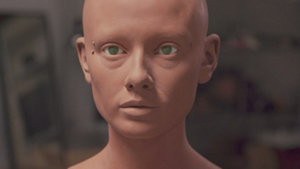
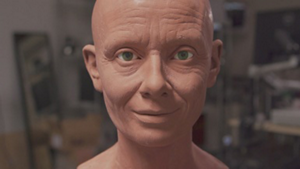
Moving on to the twice life-size sculptures
The two life-size sculptures in clay were completed after a few months of work. Kazu's next project was to create the clay sculptures at the full scale intended, namely, double the actual size of the model. He began by reproducing the face at double size using a 3D scanner and 3D printer to print out molds. He then heated the clay to soften it, filled it into the molds, and allowed it to cool and harden.
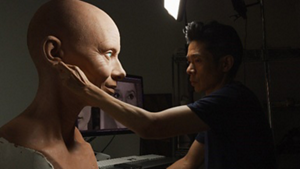
Kazu explains how he changed his process in order to create the clay sculptures at twice life size. "The eyes can take in a life-sized sculpture of a face as a whole in a matter of seconds, just as they do with a real human face. But when the scale increases, the changes perceived when the angle of view shifts are amplified. In my sculptures I exploit this effect by rendering variable expressions on a single face. With the natural limits in our human vision, our impressions are affected by the angle of vision in proportion to the size of the object viewed. While a face seen from afar may seem unitary, a face up close attracts the eye to the nuances of its different parts. In my schemes for these sculptures, I wanted the viewer's impression to change when the viewer looked upon the faces from different angles."
Intricate work on detail
In the final stage of work on his double-size clay sculptures, Kazu Hiro fashioned the skin textures using carving tools for special makeup and custom-designed tools to impress fine textural gradations into the clay. For round pores and narrow pores, he used differently shaped wire heads. For the small grooves linking the pores, he used everyday implements such as a brush for cat's fur, fingerstalls, and the mesh of an air filter. When complete, several tens of thousands of pores and several thousand grooves were intricately carved into the double-sized clay sculptures of Audrey Hepburn.

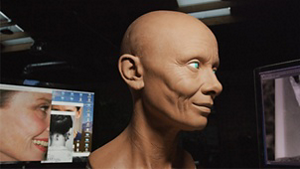
* This is not a realistic rendering of the subject but the artist's interpretation.

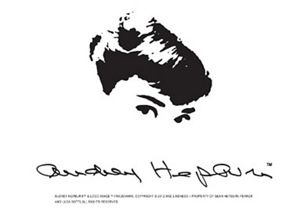
About Kao
Kao creates high-value-added products that enrich the lives of consumers around the world. Through its portfolio of over 20 leading brands such as Attack, Bioré, Goldwell, Jergens, John Frieda, Kanebo, Laurier, Merries and Molton Brown, Kao is part of the everyday lives of people in Asia, Oceania, North America and Europe. Combined with its chemical division, which contributes to a wide range of industries, Kao generates about 1,500 billion yen in annual sales. Kao employs about 33,000 people worldwide and has 130 years of history in innovation. Please visit the Kao Group website for updated information.
Media inquiries should be directed to:
Corporate Communications
Kao Corporation
